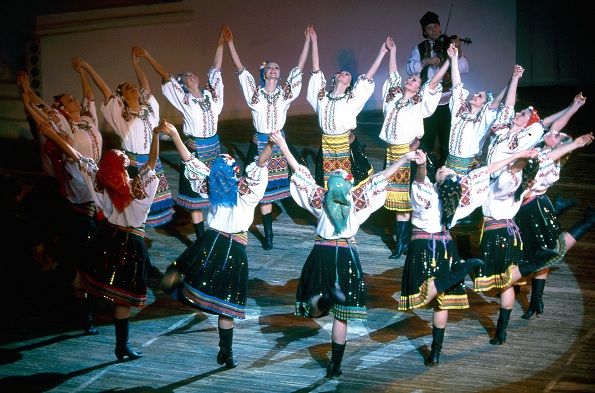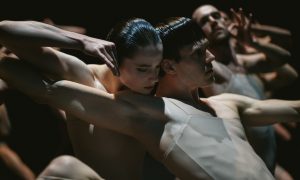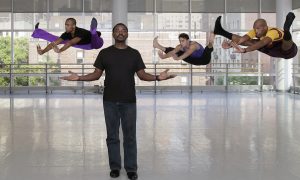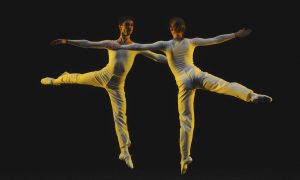By Laura Di Orio.
City Center, New York City
October 3 2012
New York City’s annual dance festival, Fall for Dance, held at City Center, is like a fruit salad of dance; twenty companies from all across the globe come together to present their culturally and stylistically different work in a joint program. For companies, this becomes a thrilling way to perform and be a part of the performing arts hub that is NYC. For viewers, this becomes great exposure to dance to which they may not otherwise be exposed. And tickets are only $10!
As just a sample of Fall for Dance’s many offerings, Program 3, presented on October 2 and 3, proved to be exemplary in what the festival’s mission seems to be. Four diverse companies: Ballet West, TU Dance, Nan Jombang and Moiseyev Dance Company appeared on the evening’s program and joined together to be a satiating night of dance, with something for everyone.
Ballet West, most recently known for being the subject of the hit reality show, Breaking Pointe, opened the program. Probably a crowd draw, Ballet West’s performance of the Grand Pas from Paquita featured some of Breaking Pointe’s stars: Christiana Bennett, Rex Tilton and Beckanne Sisk. Their Paquita, choreographed and staged by Elena Kunikova, was the center of a few of the reality show’s episodes, so this evening’s performance was a reality of that “reality”.
The dancers graced the stage with lovely golden costumes in front of a simple, delicately strung white chiffon set. The company, full of technicians with beautiful facilities accentuated by their legs and feet, presented a pristine version of Paquita. The simple subtleties in port de bras, placement of the limbs and even fingers and eyes, showed that their choreographer and coach, Kunikova, cares a great deal about detail and things that seem to be sometimes neglected nowadays.
In fact, when Dance Informa spoke with Ballet West’s Artistic Director, Adam Sklute, during intermission, he said, “I loved Elena’s work. She is meticulous about details, and that is our own approach to work.”
Kunikova created beautiful pictures and designs with diagonals and semi-circles surrounding the ballet’s central couple, Bennett and Tilton. Her choreography stressed that the corps de ballet is just as important as any leading dancer. Moments like developés and penchés on flat (which are harder than they may appear) made Paquita a technically challenging ballet for all.
Sisk and Sayaka Ohtaki undoubtedly stood out during the ballet’s series of four solos. Sisk’s confidence and calmness were contagious. She is quiet and fluid, yet also a strong powerhouse and surely someone to watch climb the ranks. Ohtaki’s demanding solo was impressive too. It was hard to believe such a huge jump could come from such a petite figure. Her cabriole with a breathy tendu drag out of it was one of the ballet’s sweetest moments. Bennett, too, proved to be a most confident, capable dancer with her quiet control and respect for gestural elegance.
All in all, Ballet West’s Paquita was a romantic look into the past with a still steadfast march into the future and demands of today’s technique. The company was successful, with probably much credit to Kunikova. I only wish the recording would have been less muffled sounding.
The next company on the bill, TU Dance, presented High Heel Blues, a duet performed by choreographer Uri Sands and his partner Yusha Marie Sorzano. The piece was set to music by Tuck and Patti – a funny song about the dilemma of “to wear heels or to not”. Ironically, Sorzano danced in flat ballet slippers and slipped in some strong flexing of her feet. The lyrics sometimes matched the movement, but not in an overdone, clichéd way. More so, the feel of the song related to the sing-songy sway of the dance and added humor and lightness.
Sorzano and Sands are so satisfying to watch, both as individuals and as a duo. Both have gorgeous technique, move like water and have a wonderful sense of abandonment. High Heel Blues was a refreshing piece that exuded the joy and fun of dance.
Next, Nan Jombang, an Indonesian dance company, presented Tarian Malam (Night Dances), a piece that uses traditional dance and martial arts to tell the story of the 2009 earthquake that struck their region. The work began in a most quiet way – with just one female dancer and a drum. The stage remained quiet for a long moment, and then the dancer began to sing and chant. She was then joined by a man, who entered and seemed to be speaking to the woman. Soon eight dancers were on stage, with more large, ornate drums.
The piece started very slowly, and perhaps the audience began to become impatient or ready for something climactic to ensue. But really the piece was like real life, maybe life in a more slow-paced culture than the audience is used to. It is sad to think that these people, minding their business, just drumming and chanting, were struck with a devastating earthquake.
Tarian Malam did pick up intensity, perhaps at the moment of the “earthquake”. The dancers drummed on their bare chests and taut red skirts, which became part of the work’s music, and the females swung their long hair in circles, which became part of the visual. There was urgency and passion, and their sudden jumps and screams seemed like a release. Tarian Malam became a piece about community, ritual, music and tradition, and a history lesson via the dance art form.
The evening’s final company, Russia’s Moiseyev Dance Company, performed several dances known as Moiseyev’s Classics. It opened with two male dancers circling a central man, who gestured and isolated his hands and shoulder blades by shaking them. We noticed immediately the precision and immaculate footwork and stylistic characteristics like flat palms and cupped fingers. Not to mention, the piece was fun. The audience couldn’t help but laugh and clap along.
All of Moiseyev’s classic dances were happy and playful, some flirtatious and fun, but therein laid solid choreographic construction. Patterns were important, gestural precision was crucial, and the dancers were strong and flexible with a versatile technique. The women had delicate, expressive balletic arms, and the men were powerful in their jumps and “tricks”. There was a sense of community here, too – dancers cheered each other on, the men stood around and watched the women as they danced, and the men took turns “showing off”.
Moiseyev’s Classics was a perfect ending to a night of dance. It was joyful and colorful, and it was a reminder of what Fall for Dance should be all about – exposing the audience to a wide variety of movement and making them fall in love with this timeless art form.
Photo: Moiseyev Dance Company, Suite of Moldavian Dances. Photo by E.Masalkov.















